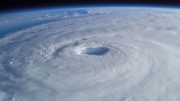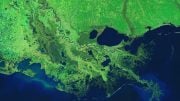
A Tulane University study published in Nature Communications reveals the potential long-term effects of climate change on coastal wetlands, using a real-world experiment along the Gulf Coast. By leveraging a network of nearly 400 monitoring sites and novel satellite data techniques, the study found that nearly 90% of sites were unable to keep pace with the rapid sea-level rise, simulating conditions expected around 2070. The research underscores the urgency of adhering to the Paris Agreement to mitigate future wetland loss. Credit: SciTechDaily.com
New research on coastal wetlands indicates that without significant carbon emission reductions, 75% of these areas will be in deficit by 2070, potentially leading to extensive wetland loss.
A new Tulane University study published today (February 15) in Nature Communications offers a glimpse into the possible impact of climate change on coastal wetlands 50 years or longer into the future.
Scientists are usually forced to rely on computer models to project the long-term effects of rising seas. However, an unexpected set of circumstances enabled a real-world experiment along the Gulf Coast.
Real-World Experimentation on the Gulf Coast
An extensive network of nearly 400 monitoring sites was established along the Louisiana coast after hurricanes Katrina and Rita. Then the rate of sea-level rise in the region surged to more than 10 millimeters (half an inch) per year – at least three times the global average. That exposed the region to the kind of ocean rise not expected until around 2070. The accelerated rise created a unique opportunity to determine whether the marshes can survive that pace of coastal flooding.
“It is the dream of every field researcher who does experiments – we can basically travel 50 years into the future to get a peek at what’s in store,” said Torbjörn Törnqvist, Vokes Geology Professor in the Tulane Department of Earth and Environmental Sciences.
Innovative Techniques and Findings
The researchers used new techniques developed by European scientists to measure sea-level rise right off the coast with satellite data, something that was previously not available. The team then compared the rate of water-level rise at each monitoring site with the rate of wetland elevation change determined by other instruments and found that almost 90% of the sites were in deficit.
A Comprehensive Climate Impact Experiment
“To our knowledge, this is the first time that a climate impact experiment has been carried out over a region this large, based on hundreds of monitoring stations that have collected data for about 15 years,” said Guandong Li, a PhD candidate in Earth and Environmental Sciences at Tulane who led the study. “This has also allowed us to study the climate impact on a heavily human-influenced landscape, rather than a more resilient pristine ecosystem.”
Li was investigating the role of land subsidence in coastal Louisiana when a team led by Sönke Dangendorf, the David and Jane Flowerree Professor in Tulane’s Department of River-Coastal Science and Engineering, demonstrated the unprecedented rates of sea-level rise along the Gulf and Southeast U.S. coasts since 2010.
“Guandong immediately dropped everything he was working on to take advantage of this unique opportunity,” Törnqvist said. “He set out to answer the key question of whether coastal marshes can keep up with this rate of sea-level rise, as some earlier modeling studies had suggested they can.”
Projected Outcomes and Hope for the Future
If the current climate scenario persists, the rate of sea-level rise by 2070 is expected to be about 7 millimeters (one-quarter inch) per year. The study projects that approximately 75% of wetland sites will be in deficit by that time, potentially resulting in a rate of wetland loss much higher than what has already occurred in the past century.
However, the researchers emphasize that there is hope for a more favorable outcome if immediate action is taken. By meeting the targets set by the Paris Agreement and reducing carbon emissions, it is possible to shift to a more sustainable climate trajectory that would reduce the rate of wetland loss.
Reference: “Real-world time-travel experiment shows ecosystem collapse due to anthropogenic climate change” by Guandong Li, Torbjörn E. Törnqvist and Sönke Dangendorf, 15 February 2024, Nature Communications.
DOI: 10.1038/s41467-024-45487-6
The study was funded by the U.S. Department of the Treasury through Louisiana’s Coastal Protection and Restoration Authority’s Center of Excellence Research Grants Program (RESTORE Act).









“If the current climate scenario persists, the rate of sea-level rise by 2070 is expected to be about 7 millimeters (one-quarter inch) per year.”
That is a big “if.” A link to a previous SciTechDaily article about work being done at Tulane, by these same authors, says, “They conclude that the rates will likely return to the more moderate values as predicted by climate models in the coming decades.”
Extrapolation of recent short-term behavior is always fraught with risk because sea level rise isn’t a straight line. While a first-order regression line with a high r^2 can be fitted to historical data, the actual data create a wiggly line that goes up AND down. Furthermore, there is some question about the splicing of data from different satellites.
Personally, I’m more inclined to attribute the apparent gulf coast behavior to subsidence and erosion rather than thermosteric volume increase of local sea water. Where is the evidence of anomalous temperature increase in the Gulf and SE US ocean waters?